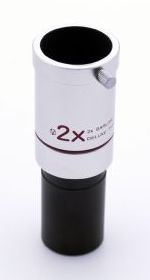The Barlow lens & Reducer lenses
The Barlow lensA Barlow lens is an optical device which is usually inserted between the eyepiece and the focuser. Inside is a negative lens that increases the focal length of the telescope artificially. A Barlow is often not a single lens, but a system of lens elements. This is usually employed to reduce chromatic aberration and, in this case, the lens is often referred to as an achromatic Barlow. Standard Barlows have a 2X magnification factor. The function of such a lens can be best explained using an example: Let us look at a 200/1000mm Newtonian reflector, such as the Omegon Advanced Telescope. An eyepiece with 6mm focal length is used for this purpose. The magnification formula results in a 166X magnification. A Barlow with a magnification factor of 2X extends the focal length of the telescope from 1000mm to 2000mm. Using the same eyepiece, this results in double the magnification, i.e. 330X. With an eyepiece and a Barlow lens provides you with two possible magnifications. Of course you will have a much better range of magnifications available if you take care to match the eyepieces to the Barlow when first buying your eyepieces. But there is a problem: A Barlow is an additional component, containing lens elements. Each lens element reflects light from its optical surfaces and also absorbs light internally. This means that less light finally arrives at the eye. That is why you should really consider when a Barlow lens is useful. A Barlow lens should not be used as a substitute for a good eyepiece if at all possible. Of course, there are now really high quality Barlows that provide a good image. However, these Barlows are usually in higher price range. Another application where using a Barlow makes sense is in webcam astrophotography. Barlow lenses are really necessary in this type of astrophotography. As you usually photograph planets with webcams, using a Barlow with a high magnification factor makes sense. These lenses are available with a 3X or 5X magnification factor. Reducer lenses for shortening the focal lengthIn addition to Barlows, there are also lenses which shorten the focal length of the telescope. This type of lens was previously mainly known as a Shapley lenses, but today they are known as a ‘reducer’. While a Barlow uses a diverging lens system for the magnification effect it causes, a reducer works in the other direction. It is equipped with a converging lens and the positive power of this lens decreases the focal length of the telescope. This component also often consists of more than one lens element and these working together have an overall positive, i.e. converging, effect. They often have three lens elements, with two converging and one diverging lens element, which are cemented together. These lenses are used mostly useful in Cassegrain telescopes and their Schmidt-Cassegrain or Maksutov-Cassegrain variants. These telescope systems all have a relatively long focal length. The aperture ratio is usually 1:10 or more. A 250mm Schmidt-Cassegrain telescope has at an aperture ratio of 1:10, meaning a focal length of 2500mm. This may be a too large for some purposes. Long focal lengths produce very small fields of view with astrophotography, and one has virtually no chance of capturing extended objects on the camera chip without the use of such a reducer. |
|


